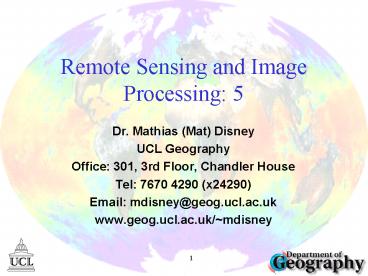Remote Sensing and Image Processing: 5 - PowerPoint PPT Presentation
1 / 24
Title:
Remote Sensing and Image Processing: 5
Description:
Atmospheric irradiance. reflectance outside target scattered into path. diffuse atmospheric irradiance. multiple-scattered surface-atmosphere interactions ... – PowerPoint PPT presentation
Number of Views:53
Avg rating:3.0/5.0
Title: Remote Sensing and Image Processing: 5
1
Remote Sensing and Image Processing 5
- Dr. Mathias (Mat) Disney
- UCL Geography
- Office 301, 3rd Floor, Chandler House
- Tel 7670 4290 (x24290)
- Email mdisney_at_geog.ucl.ac.uk
- www.geog.ucl.ac.uk/mdisney
2
EMR arriving at Earth
- We now know how EMR spectrum is distributed
- Radiant energy arriving at Earths surface
- NOT blackbody, but close
- This lecture..
- Interactions of EMR with atmosphere
- scattering
- Atmospheric windows and choosing the right
place for bands - Interactions at the surface
- Scattering and angular effects
3
Departure from blackbody assumption
- Interaction with gases in the atmosphere
- attenuation of solar radiation
4
Interactions with the atmosphere
- Notice that target reflectance is a function of
- Atmospheric irradiance
- reflectance outside target scattered into path
- diffuse atmospheric irradiance
- multiple-scattered surface-atmosphere interactions
From http//www.geog.ucl.ac.uk/mdisney/phd.bak/f
inal_version/final_pdf/chapter2a.pdf
5
Interactions with the atmosphere scattering
- Caused by presence of particles (soot, salt,
etc.) and/or large gas molecules present in the
atmosphere - Interact with EMR and cause to be redirected from
original path. - Scattering amount depends on
- ? of radiation
- abundance of particles or gases
- distance the radiation travels through the
atmosphere (path length)
After http//www.ccrs.nrcan.gc.ca/ccrs/learn/tuto
rials/fundam/chapter1/chapter1_4_e.html
6
Atmospheric scattering 1 Rayleigh
- Particle size ltlt ? of radiation
- e.g. very fine soot and dust or N2, O2 molecules
- Rayleigh scattering dominates shorter ? and in
upper atmos. - i.e. Longer ? scattered less (visible red ?
scattered less than blue ?) - Hence during day, visible blue ? tend to dominate
(shorter path length) - Longer path length at sunrise/sunset so
proportionally more visible blue ? scattered out
of path so sky tends to look more red - Even more so if dust in upper atmosphere
- http//www.spc.noaa.gov/publications/corfidi/sunse
t/ - http//www.nws.noaa.gov/om/educ/activit/bluesky.ht
m
After http//www.ccrs.nrcan.gc.ca/ccrs/learn/tuto
rials/fundam/chapter1/chapter1_4_e.html
7
Atmospheric scattering 2 Mie
- Particle size ? ? of radiation
- e.g. dust, pollen, smoke and water vapour
- Affects longer ? than Rayleigh, BUT weak
dependence on ? - Mostly in the lower portions of the atmosphere
- larger particles are more abundant
- dominates when cloud conditions are overcast
- i.e. large amount of water vapour (mist, cloud,
fog) results in almost totally diffuse
illumination
After http//www.ccrs.nrcan.gc.ca/ccrs/learn/tuto
rials/fundam/chapter1/chapter1_4_e.html
8
Atmospheric scattering 3 Non-selective
- Particle size gtgt ? of radiation
- e.g. Water droplets and larger dust particles,
- All ? affected about equally (hence name!)
- Hence results in fog, mist, clouds etc. appearing
white - white equal scattering of red, green and blue ?
s
After http//www.ccrs.nrcan.gc.ca/ccrs/learn/tuto
rials/fundam/chapter1/chapter1_4_e.html
9
Atmospheric absorption
- Other major interaction with signal
- Gaseous molecules in atmosphere can absorb
photons at various ? - depends on vibrational modes of molecules
- Very dependent on ?
- Main components are
- CO2, water vapour and ozone (O3)
- Also CH4 ....
- O3 absorbs shorter ? i.e. protects us from UV
radiation
10
Atmospheric windows
- As a result of strong ? dependence of absorption
- Some ? totally unsuitable for remote sensing as
most radiation absorbed
11
Atmospheric windows
- If you want to look at surface
- Look in atmospheric windows where transmissions
high - BUT if you want to look at atmosphere ....pick
gaps - Very important when selecting instrument channels
- Note atmosphere nearly transparent in ?wave i.e.
can see through clouds! - BIG advantage of ?wave remote sensing
12
Atmospheric windows
- Vivisble NIR part of the spectrum
- windows, roughly 400-750, 800-1000, 1150-1300,
1500-1600, 2100-2250nm
13
Recap
- Signal we measure contains atmospheric
contamination (or information depending on your
point of view!) - Rayleigh (fine dust and gases), Mie (bigger
particles) and non-selective scattering (water
vapour and the rest) - Perform atmospheric correction to get at surface
signal - Part of pre-processing steps (see later)
- So what happens at the surface?
14
Reflectance
- When EMR hits target (surface)
- Range of surface reflectance behaviour
- perfect specular (mirror-like) - incidence angle
exitance angle - perfectly diffuse (Lambertian) - same reflectance
in all directions independent of illumination
angle)
From http//www.ccrs.nrcan.gc.ca/ccrs/learn/tutori
als/fundam/chapter1/chapter1_5_e.html
15
Surface energy budget
- Total amount of radiant flux per wavelength
incident on surface, ?(?) W?m-1 is summation of - reflected r?, transmitted t?, and absorbed, a?
- i.e. ?(?) r? t? a?
- So need to know about surface reflectance,
transmittance and absorptance - Measured RS signal is combination of all 3
components
After Jensen, J. (2000) Remote sensing of the
environment an Earth Resources Perspective.
16
Angular distribution of reflectance
- Real surfaces usually display some degree of
reflectance ANISOTROPY - Lambertian surface is isotropic by definition
- Most surfaces have some level of anisotropy
- Described by Bidirectional Reflectance
Distribution Function (BRDF)
From http//www.geog.ucl.ac.uk/mdisney/phd.bak/f
inal_version/final_pdf/chapter2a.pdf
17
Directional Information
18
Features of BRDF
- Bowl shape
- increased scattering due to increased path length
through canopy
19
Features of BRDF
- Bowl shape
- increased scattering due to increased path length
through canopy
20
(No Transcript)
21
Features of BRDF
- Hot Spot
- mainly shadowing minimum
- so reflectance higher
22
(No Transcript)
23
Directional reflectance BRDF
- Good explanation of BRDF
- http//geography.bu.edu/brdf/brdfexpl.html
24
Summary
- Top-of-atmosphere (TOA) signal is NOT target
signal - function of target reflectance
- plus atmospheric component (scattering,
absorption) - need to choose appropriate regions (atmospheric
windows) - Surface reflectance is anisotropic
- i.e. looks different in different directions
- described by BRDF
- angular signal contains information on size,
shape and distribution of objects on surface































